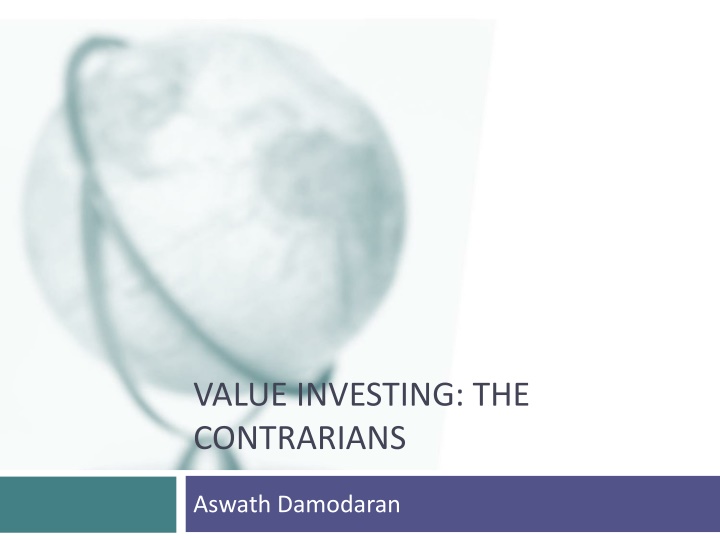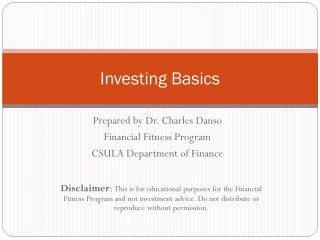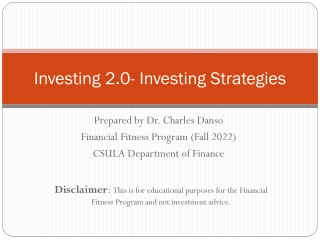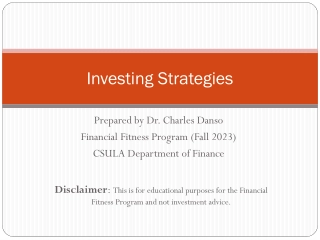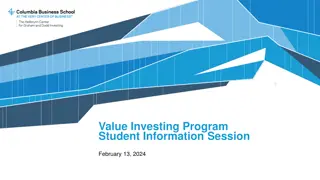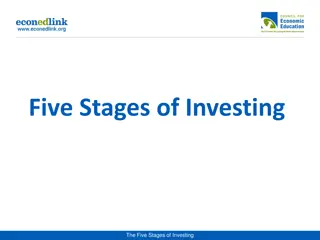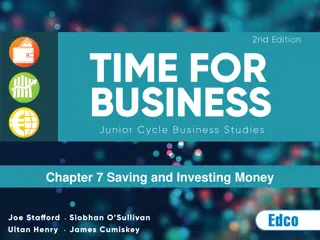Contrarian Value Investing: Buying the Losers
Contrarian value investing involves identifying undervalued stocks that have experienced negative news, as markets tend to overreact. Studies show a trend of negative serial correlation in returns, indicating a potential for price reversals in the long term for stocks that have performed poorly previously. The analysis suggests that loser portfolios tend to outperform winner portfolios in the sixty months following creation, although caution is advised due to potential risks associated with low-priced stocks.
Download Presentation

Please find below an Image/Link to download the presentation.
The content on the website is provided AS IS for your information and personal use only. It may not be sold, licensed, or shared on other websites without obtaining consent from the author.If you encounter any issues during the download, it is possible that the publisher has removed the file from their server.
You are allowed to download the files provided on this website for personal or commercial use, subject to the condition that they are used lawfully. All files are the property of their respective owners.
The content on the website is provided AS IS for your information and personal use only. It may not be sold, licensed, or shared on other websites without obtaining consent from the author.
E N D
Presentation Transcript
VALUE INVESTING: THE CONTRARIANS Aswath Damodaran
Contrarian Value Investing: Buying the Losers In contrarian value investing, you begin with the proposition that markets over react to good and bad news. Consequently, stocks that have had bad news come out about them (earnings declines, deals that have gone bad) are likely to be under valued. Evidence that Markets Overreact to News Announcements Studies that look at returns on markets over long time periods chronicle that there is significant negative serial correlation in returns, I.e, good years are more likely to be followed by bad years and vice versal. Studies that focus on individual stocks find the same effect, with stocks that have done well more likely to do badly over the next period, and vice versa. 2
1. The Bludgeon Approach Buy losers Since there is evidence that prices reverse themselves in the long term for entire markets, it might be worth examining whether such price reversals occur on classes of stock within a market. For instance, are stocks which have gone up the most over the last period more likely to go down over the next period and vice versa? To isolate the effect of such price reversals on the extreme portfolios, DeBondt and Thaler constructed a winner portfolio of 35 stocks, which had gone up the most over the prior year, and a loser portfolio of 35 stocks, which had gone down the most over the prior year, each year from 1933 to 1978. 3
More on Winner and Loser Portfolios This analysis suggests that loser portfolio clearly outperform winner portfolios in the sixty months following creation. This evidence is consistent with market overreaction and correction in long return intervals. There are many, academics as well as practitioners, who suggest that these findings may be interesting but that they overstate potential returns on 'loser' portfolios. There is evidence that loser portfolios are more likely to contain low priced stocks (selling for less than $5), which generate higher transactions costs and are also more likely to offer heavily skewed returns, i.e., the excess returns come from a few stocks making phenomenal returns rather than from consistent performance. Studies also seem to find loser portfolios created every December earn significantly higher returns than portfolios created every June. Finally, you need a long time horizon for the loser portfolio to win out. 5
2. A more refined contrarian strategy The peril of investing in stocks that have gone down the most is that you may be also investing in stocks that have had fundamental business break downs or are on a pathway to bankruptcy. In a more refined version of contrarian investing, you are looking for companies whose stock prices have dropped more than their fundamentals suggest that they should have. This can arise because: Investors have over reacted to a news announcement and pushed prices down too much. A market crisis has caused a sell off, where investors are panicked and are selling all stocks (good and bad) An entire sector (group) is being sold off because of sector-wide or macro news. 7
Implementing the strategy: The Crisis Entry version 9 Entry points: In this strategy, you turn your attention to a company when it is in crisis, either individually or as part of a group. Generally, the market price for the company will have dropped in the period or periods before your assessment. Valuation: You value the company, updating the fundamentals to reflect what you have learned from the triggering news about the company. Check against pricing: You compare to the pricing of the company to see if it is cheap, given its updated valuation. Aswath Damodaran 9
A more general screening approach Multiple Mismatch for cheap Mismatch for expensive Low PE, High growth, Low Equity Risk, High Payout High PE, Low growth, High Equity Risk, Low Payout PE Low PEG, Low Growth, Low Equity Risk, High Payout High PEG, High Growth, High Equity Risk, Low Payout PEG Low PBV, High Growth, Low Equity Risk, High ROE High PBV, Low Growth, High Equity Risk, Low ROE PBV EV/Invested Capital Low EV/IC, High Growth, Low Operating Risk, High ROIC Low EV/Sales, High Growth, Low Operating Risk, High Operating Margin High EV/IC, Low Growth, High Operating Risk, Low ROIC High EV/Sales, Low Growth, High Operating Risk, High Operating Margin EV/Sales Low EV/EBITDA, High Growth, Low Operating Risk, Low Tax Rate High EV/EBITDA, Low Growth, High Operating Risk, High Tax Rate EV/EBITDA 10
Determinants of Success at Contrarian Investing Self Confidence: Investing in companies that everybody else views as losers requires a self confidence that comes either from past success, a huge ego or both. Clients/Investors who believe in you: You either need clients who think like you do and agree with you, or clients that have made enough money of you in the past that their greed overwhelms any trepidiation you might have in your portfolio. Patience: These strategies require time to work out. For every three steps forward, you will often take two steps back. Stomach for Short-term Volatility: The nature of your investment implies that there will be high short term volatility and high profile failures. Watch out for transactions costs: These strategies often lead to portfolios of low priced stocks held by few institutional investors. The transactions costs can wipe out any perceived excess returns quickly. 1. 2. 3. 4. 5. 11
